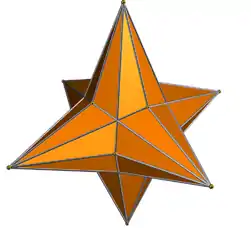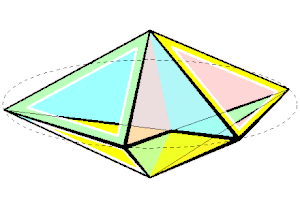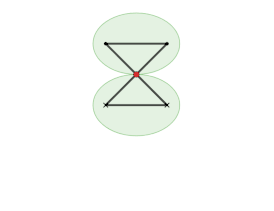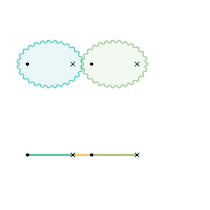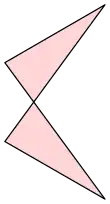
In geometry, an antiparallelogram is a type of self-crossing quadrilateral. Like a parallelogram, an antiparallelogram has two opposite pairs of equal-length sides, but these pairs of sides are not in general parallel. Instead, each pair of sides is antiparallel with respect to the other, with sides in the longer pair crossing each other as in a scissors mechanism. Whereas a parallelogram's opposite angles are equal and oriented the same way, an antiparallelogram's are equal but oppositely oriented. Antiparallelograms are also called contraparallelograms[1] or crossed parallelograms.[2]
Antiparallelograms occur as the vertex figures of certain nonconvex uniform polyhedra. In the theory of four-bar linkages, the linkages with the form of an antiparallelogram are also called butterfly linkages or bow-tie linkages, and are used in the design of non-circular gears. In celestial mechanics, they occur in certain families of solutions to the 4-body problem.
Every antiparallelogram has an axis of symmetry, with all four vertices on a circle. It can be formed from an isosceles trapezoid by adding the two diagonals and removing two parallel sides. The signed area of every antiparallelogram is zero.
Geometric properties
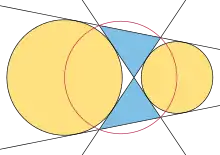
An antiparallelogram is a special case of a crossed quadrilateral, with two pairs of equal-length edges.[3] In general, crossed quadrilaterals can have unequal edges.[3] A special form of the antiparallelogram is a crossed rectangle, in which two opposite edges are parallel.[4] Every antiparallelogram is a cyclic quadrilateral, meaning that its four vertices all lie on a single circle.[3] Additionally, the four extended sides of any antiparallelogram are the bitangents of two circles, making antiparallelograms closely related to the tangential quadrilaterals, ex-tangential quadrilaterals, and kites (which are both tangential and ex-tangential).[5]
Every antiparallelogram has an axis of symmetry through its crossing point. Because of this symmetry, it has two pairs of equal angles and two pairs of equal sides.[2] The four midpoints of its sides lie on a line perpendicular to the axis of symmetry; that is, for this kind of quadrilateral, the Varignon parallelogram is a degenerate quadrilateral of area zero, consisting of four collinear points.[6][7] The convex hull of an antiparallelogram is an isosceles trapezoid, and every antiparallelogram may be formed from an isosceles trapezoid (or its special cases, the rectangles and squares) by replacing two parallel sides by the two diagonals of the trapezoid.[4]
Because an antiparallelogram forms two congruent triangular regions of the plane, but loops around those two regions in opposite directions, its signed area is the difference between the regions' areas and is therefore zero.[7] The polygon's unsigned area (the total area it surrounds) is the sum, rather than the difference, of these areas. For an antiparallelogram with two parallel diagonals of lengths and , separated by height , this sum is .[4] It follows from applying the triangle inequality to these two triangular regions that the crossing pair of edges in an antiparallelogram must always be longer than the two uncrossed edges.[8]
Applications
In polyhedra
Several nonconvex uniform polyhedra, including the tetrahemihexahedron, cubohemioctahedron, octahemioctahedron, small rhombihexahedron, small icosihemidodecahedron, and small dodecahemidodecahedron, have antiparallelograms as their vertex figures, the cross-sections formed by slicing the polyhedron by a plane that passes near a vertex, perpendicularly to the axis between the vertex and the center.[9]
One form of a non-uniform but flexible polyhedron, the Bricard octahedron, can be constructed as a bipyramid over an antiparallelogram.[10]
Four-bar linkages
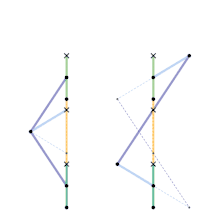
Dotted links indicate the last link required for the fourth connection.
The antiparallelogram has been used as a form of four-bar linkage, in which four rigid beams of fixed length (the four sides of the antiparallelogram) may rotate with respect to each other at joints placed at the four vertices of the antiparallelogram. In this context it is also called a butterfly or bow-tie linkage. As a linkage, it has a point of instability in which it can be converted into a parallelogram and vice versa, but either of these linkages can be braced to prevent this instability.[12][11]
For both the parallelogram and antiparallelogram linkages, if one of the long (crossed) edges of the linkage is fixed as a base, the free joints move on equal circles, but in a parallelogram they move in the same direction with equal velocities while in the antiparallelogram they move in opposite directions with unequal velocities.[13] As James Watt discovered, if an antiparallelogram has its long side fixed in this way, the midpoint of the unfixed long edge will trace out a lemniscate or figure eight curve. For the antiparallelogram formed by the sides and diagonals of a square, it is the lemniscate of Bernoulli.[14][15]
The antiparallelogram with its long side fixed is a variant of Watt's linkage.[14] An antiparallelogram is an important feature in the design of Hart's inversor, a linkage that (like the Peaucellier–Lipkin linkage) can convert rotary motion to straight-line motion.[16] An antiparallelogram-shaped linkage can also be used to connect the two axles of a four-wheeled vehicle, decreasing the turning radius of the vehicle relative to a suspension that only allows one axle to turn.[2] A pair of nested antiparallelograms was used in a linkage defined by Alfred Kempe as part of Kempe's universality theorem, stating that any algebraic curve may be traced out by the joints of a suitably defined linkage. Kempe called the nested-antiparallelogram linkage a "multiplicator", as it could be used to multiply an angle by an integer.[1] Used in the other direction, to divide angles, it can be used for angle trisection (although not as a straightedge and compass construction).[17] Kempe's original constructions using this linkage overlooked the parallelogram-antiparallelogram instability, but bracing the linkages fixes his proof of the universality theorem.[12]
Gear design
Suppose that one of the uncrossed edges of an antiparallelogram linkage is fixed in place, and the remaining linkage moves freely. As the linkage moves, each antiparallelogram formed can be divided into two congruent triangles meeting at the crossing point. In the triangle based on the fixed edge, the lengths of the two moving sides sum to the constant length of one of the antiparallelogram's crossed edges, and therefore the moving crossing point traces out an ellipse with the fixed points as its foci. Symmetrically, the second (moving) uncrossed edge of the antiparallelogram has as its endpoints the foci of a second ellipse, formed from the first one by reflection across a tangent line through the crossing point.[2][18] Because the second ellipse rolls around the first, this construction of ellipses from the motion of an antiparallelogram can be used in the design of elliptical gears that convert uniform rotation into non-uniform rotation or vice versa.[19]
Celestial mechanics
In the n-body problem, the study of the motions of point masses under Newton's law of universal gravitation, an important role is played by central configurations, solutions to the n-body problem in which all of the bodies rotate around some central point as if they were rigidly connected to each other. For instance, for three bodies, there are five solutions of this type, given by the five Lagrangian points. For four bodies, with two pairs of the bodies having equal masses (but with the ratio between the masses of the two pairs varying continuously), numerical evidence indicates that there exists a continuous family of central configurations, related to each other by the motion of an antiparallelogram linkage.[20]
References
- 1 2 Demaine, Erik; O'Rourke, Joseph (2007), Geometric Folding Algorithms, Cambridge University Press, pp. 32–33, doi:10.1017/CBO9780511735172, ISBN 978-0-521-85757-4, MR 2354878
- 1 2 3 4 Bryant, John; Sangwin, Christopher J. (2008), "3.3 The Crossed Parallelogram", How Round Is Your Circle? Where Engineering and Mathematics Meet, Princeton University Press, pp. 54–56, ISBN 978-0-691-13118-4.
- 1 2 3 Begalla, Engjëll; Perucca, Antonella (2020), "The ABCD of cyclic quadrilaterals", Uitwiskeling, University of Luxembourg, hdl:10993/43232
- 1 2 3 Alsina, Claudi; Nelsen, Roger B. (2020), A Cornucopia of Quadrilaterals, The Dolciani Mathematical Expositions, vol. 55, Providence, Rhode Island: MAA Press and American Mathematical Society, p. 212, ISBN 978-1-4704-5312-1, MR 4286138
- ↑ Wheeler, Roger F. (1958), "Quadrilaterals", The Mathematical Gazette, 42 (342): 275–276, doi:10.2307/3610439, JSTOR 3610439, S2CID 250434576
- ↑ Muirhead, R. F. (February 1901), "Geometry of the isosceles trapezium and the contra-parallelogram, with applications to the geometry of the ellipse", Proceedings of the Edinburgh Mathematical Society, 20: 70–72, doi:10.1017/s0013091500032892
- 1 2 De Villiers, Michael (2015), "Slaying a geometrical 'monster': finding the area of a crossed quadrilateral", Learning and Teaching Mathematics, 2015 (18): 23–28, hdl:10520/EJC175721
- ↑ The same argument proves more generally that in any convex quadrilateral (such as the isosceles trapezoid from which an antiparallelogram is derived) the sum of the two diagonals is longer than the sum of any two opposite sides. In the isosceles trapezoid, the two diagonals are equal, as are the two opposite sides, simplifying this inequality. For the use of the triangle inequality to prove the inequality on sums of diagonals see e.g. Demaine & O'Rourke (2007, p. 80)
- ↑ Coxeter, H. S. M.; Longuet-Higgins, M. S.; Miller, J. C. P. (1954), "Uniform polyhedra", Philosophical Transactions of the Royal Society of London. Series A, Mathematical and Physical Sciences, 246 (916): 401–450, Bibcode:1954RSPTA.246..401C, doi:10.1098/rsta.1954.0003, JSTOR 91532, MR 0062446, S2CID 202575183
- ↑ Demaine & O'Rourke (2007), Section 23.2, "Flexible polyhedra", pp. 345–348
- 1 2 Abbott, Timothy Good (2008), "3.1.2 Contraparallelograms", Generalizations of Kempe's Universality Theorem (PDF) (Master's thesis), Massachusetts Institute of Technology, pp. 34–36
- 1 2 Sossinsky, Alexey (2016), "Configuration spaces of planar linkages", Handbook of Teichmüller theory, Vol. VI, IRMA Lectures in Mathematics and Theoretical Physics, vol. 27, Zürich: European Mathematical Society, pp. 335–373, MR 3618193; see p. 359
- ↑ Norton, Robert L. (2003), Design of Machinery, McGraw-Hill Professional, p. 51, ISBN 978-0-07-121496-4
- 1 2 Bryant & Sangwin (2008), pp. 58–59
- ↑ Cundy, H. Martyn (March 2005), "89.23 The lemniscate of Bernoulli", The Mathematical Gazette, 89 (514): 89–93, doi:10.1017/s0025557200176855, S2CID 125521872
- ↑ Dijksman, E. A. (1976), Motion Geometry of Mechanisms, Cambridge University Press, p. 203, ISBN 9780521208413
- ↑ Yates, Robert C. (March 1941), "The trisection problem", National Mathematics Magazine, 15 (6): 278–293, doi:10.2307/3028413, JSTOR 3028413
- ↑ van Schooten, Frans (1646), De Organica Conicarum Sectionum In Plano Descriptione, Tractatus. Geometris, Opticis; Præsertim verò Gnomonicis et Mechanicis Utilis. Cui subnexa est Appendix, de Cubicarum Æquationum resolutione, pp. 49–50, 69–70
- ↑ Glaeser, Georg (2020), "Antiparallelograms; It does not always have to be a uniform rotation ...", Geometry and its Applications in Arts, Nature and Technology, Springer International Publishing, pp. 428–429, doi:10.1007/978-3-030-61398-3, ISBN 978-3-030-61397-6, S2CID 241160811
- ↑ Grebenikov, Evgenii A.; Ikhsanov, Ersain V.; Prokopenya, Alexander N. (2006), "Numeric-symbolic computations in the study of central configurations in the planar Newtonian four-body problem", Computer algebra in scientific computing, Lecture Notes in Comput. Sci., vol. 4194, Berlin: Springer, pp. 192–204, doi:10.1007/11870814_16, MR 2279793
External links
 Media related to Antiparallelograms at Wikimedia Commons
Media related to Antiparallelograms at Wikimedia Commons

